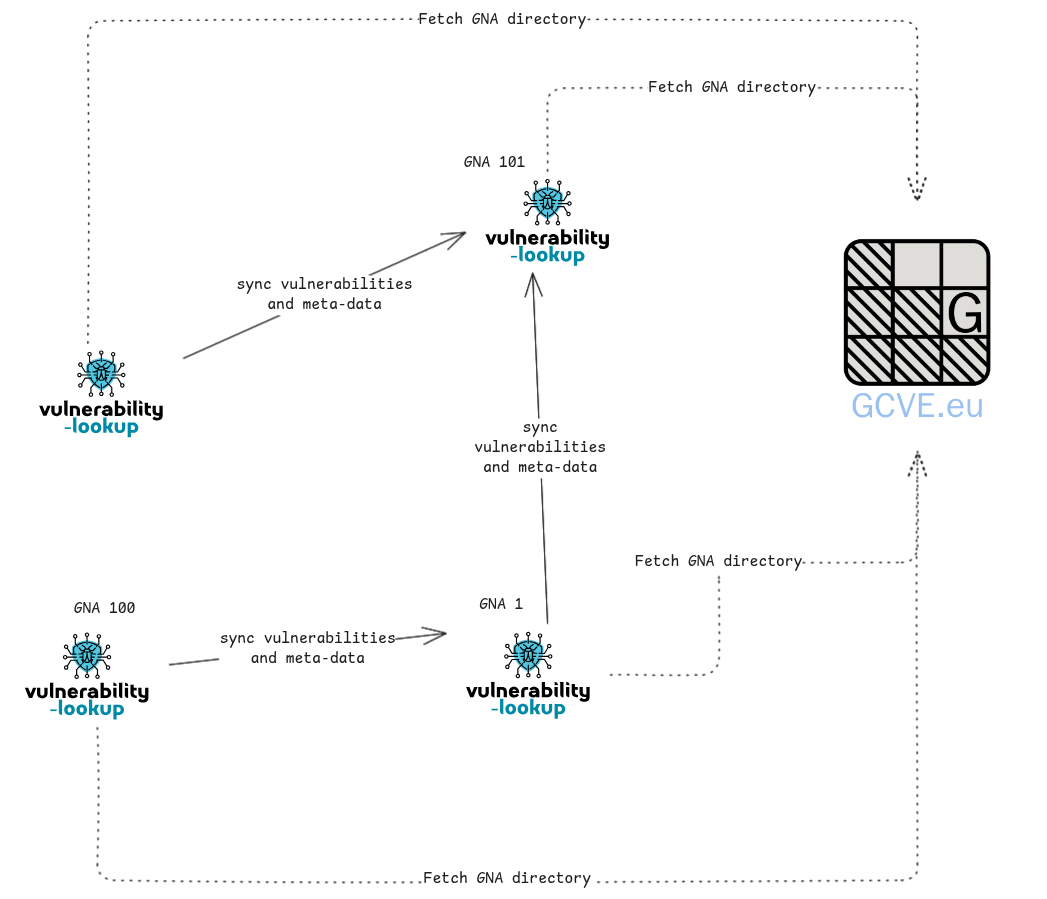FAQ
GCVE Frequently Asked Questions (FAQ)
Q1: What is GCVE?
A: GCVE (Global CVE Allocation System) is a new, decentralized system for identifying and numbering security vulnerabilities. It aims to increase flexibility, scalability, and autonomy for organizations involved in vulnerability management, while remaining compatible with the traditional CVE® system.
Q2: How is GCVE different from the traditional CVE system?
A: The main difference is decentralization. GCVE introduces GCVE Numbering Authorities (GNAs), which are independent entities that can allocate GCVE identifiers without needing blocks pre-allocated from a central authority or adhering strictly to centrally enforced policies. The traditional CVE system typically relies on a more centralized structure for ID allocation and policy.
Q3: What is a GCVE Numbering Authority (GNA)?
A: A GNA is an organization approved to assign GCVE identifiers. Each GNA gets a unique numeric ID, which becomes part of the GCVE ID format. GNAs have the autonomy to allocate IDs at their own pace and define their own internal policies for vulnerability identification.
Q4: Does GCVE replace existing CVE IDs? How does compatibility work?
A: No, GCVE does not replace existing CVE IDs. It’s designed to be backward-compatible. All existing and future standard CVE IDs are represented within the GCVE system using the reserved GNA ID 0. For example, CVE-2023-40224 can be represented as GCVE-0-2023-40224.
Q5: What is the format of a GCVE identifier?
A: A GCVE ID uses a four-part format: GCVE-<GNA ID>-<YEAR>-<UNIQUE ID>.
GCVE: Standard prefix.GNA ID: An identifier assigned to the GNA, unique for that GNA.YEAR: The year of disclosure or allocation.UNIQUE ID: The unique numeric identifier of the GNA that assigned the ID.
Q6: What are the main benefits of using the GCVE system?
A: The key benefits include:
- Decentralized Allocation: GNAs manage their own ID assignments.
- Policy Flexibility: GNAs can operate under their own guidelines.
- Scalability: Helps avoid bottlenecks found in centralized systems.
- Compatibility: Seamlessly integrates existing CVEs via
GNA ID 0.
Q7: Who is the first GNA using this model?
A: CIRCL (Computer Incident Response Center Luxembourg) is the first organization assigned a GNA ID (GNA ID 1) to use the new GCVE allocation model. GNA ID 0 is reserved for mapping existing CVEs.
Q8: Where can I find the official list of GNAs?
A: The official registry, including a list of GNAs and their IDs, is maintained at https://gcve.eu and published as JSON at the following location https://gcve.eu/dist/gcve.json.
Q9: Is there software that supports GCVE?
A: Yes. Any software handling standard CVEs can implicitly handle GCVE IDs with GNA ID 0. Additionally, the vulnerability-lookup tool supports the full GNA allocation process and GCVE format.

Q10: How can my organization become a GNA?
A: If you are an existing CNA (CVE Numbering Authority) or an organization falling into the eligibility criteria, you can send an email to gna@gcve.eu with your CNA name. You will need to provide information about your organization, like its short name and full name, similar to the format used in the GNA JSON directory file available on gcve.eu.
Q11: What information is available about GNAs on the gcve.eu website?
A: A JSON is available, containing details for each registered GNA. This includes their unique id (GNA ID), short_name, full_name, and potentially URLs for their specific GCVE data, API, dumps, and allocation process (like gcve_url, gcve_api, gcve_dump, gcve_allocation).
Q12: What is the relationship between the open source vulnerability-lookup project, the EUVD (European Union Vulnerability Database), and GCVE.eu?
Europe has a strong cybersecurity network (thanks to the EU CSIRTs network). CIRCL developed the open source vulnerability-lookup project to address past challenges in collecting diverse sources, ensuring both diversity and stability. The project is co-funded by the European DEP program (NGSOTI) and Luxembourg to support national activities under NIS2.
While maintaining the project, CIRCL identified many shortcomings in ID allocation and correlation when using and operating the vulnerability.circl.lu instance(s). To address this, we created GCVE.eu as a resilient ID allocation system, designed to ensure autonomy from various vulnerability publishers and improve stability in identifier correlation.
As part of the unified NIS2 activities within the European Union, ENISA — which leads the EU CSIRTs network — operates the EUVD, which relies on the vulnerability-lookup software. There is a strong collaboration between CIRCL and ENISA on this topic to improve coordination, tooling, and data quality across the EU vulnerability ecosystem.
Q13: Is the JSON file distributed by GCVE signed, and how can the signature be verified?
The JSON file distributed by GCVE is digitally signed using an RSA public key with SHA-512.
The public key is available at multiple locations:
- Via HTTP: https://gcve.eu/dist/key/public.pem
- Via DNS:
dig -t TXT _key.gcve.eu - On GitHub: https://raw.githubusercontent.com/gcve-eu/gcve.eu-directory/refs/heads/main/key/public.pem
Q14: How does decentralized publication work?
Vulnerability-Lookup is a reference open-source software that includes a functional model for using the GCVE.eu GNA directory. It allows each user of Vulnerability-Lookup to select which GNAs to gather vulnerability information from.
This enables GNAs to directly publish their vulnerability information without relying on a centralized system.
There is no complex technology or software involved, it’s a standard ReST API, implemented and documented as a Best Current Practice (BCP-03), which can be easily reimplemented by other software solutions.

Q15: Do you have any logos for GCVE and the GNA?
For GCVE.eu, there are two sets of logos: one set features the generic logos of the GCVE.eu project, and the other is for GNAs — GCVE Numbering Authorities. All logos are available at https://gcve.eu/logo/, including both bitmap and vector-based formats.